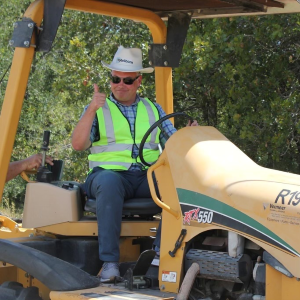Connecting neighbors to high-speed Internet service in rural Texas
By: Kevin Gallagher, Senior Advisor to the Secretary
 In August, I had the pleasure of visiting Totelcom’s offices and training facilities in De Leon, Texas. Totelcom is a family-owned, rural telecom provider that serves De Leon—with a population of just over 2,000—and the surrounding communities. As we pulled up after the two-hour drive from Dallas, the company’s digital reader board displayed a temperature of 112 degrees.
In August, I had the pleasure of visiting Totelcom’s offices and training facilities in De Leon, Texas. Totelcom is a family-owned, rural telecom provider that serves De Leon—with a population of just over 2,000—and the surrounding communities. As we pulled up after the two-hour drive from Dallas, the company’s digital reader board displayed a temperature of 112 degrees.
Inhospitable temperatures aside, the visit provided insight into the work and challenges of rural providers, and how much those challenges can vary across a state as vast and geographically diverse as Texas.
I got to experience the fieldwork firsthand when I was given a cowboy-hat-shaped hard hat and offered a seat on a cable plow. As I learned the basics of trenching and laying fiber in the hot Texas sun, I was offered a window into the experience of new employees.
Totelcom trains their workers on the job by partnering new employees with more experienced staff who show them the ropes and provide valuable mentorship. Work-based learning opportunities allow participants to develop skills that employers value but may be hard to learn in a classroom. They can also lower barriers to entry by allowing employers to bring on individuals with less educational or professional experience prior to taking the job and allow new workers to earn a paycheck while being trained.
As we work to accomplish President Biden’s goal of expanding reliable, affordable, high-speed Internet service to every corner of America, we’re going to need a skilled workforce, including thousands of new technicians, equipment operators, and engineers, just to name a few. Preparing for that workforce demand will look different for each state and territory, but understanding the workforce needs of local Internet service providers is critical.
As Secretary Raimondo says, we can’t merely “train and pray” that folks can find a job. Industry must be at the table helping to develop training programs from the start and committing to hire program graduates. And in places where local employers train new employees in-house through established curriculum, state and territory broadband offices could instead focus on ways to support recruitment efforts, helping to develop a pipeline of talent for the industry.
Last fall, NTIA released a Workforce Planning Guide to support Broadband Equity, Access, and Deployment (BEAD) Program Eligible Entities in the development of their workforce plans. The Guide offers proposed planning steps and pacing suggestions to meet programmatic requirements, but it also includes a range of strategies and examples of equitable training and workforce development efforts from across the country.
While I only got a quick crash course, I was struck by the pride of the Totelcom technicians I met. Their work allows their neighbors to get online – helping them to access new educational and professional opportunities, connecting them to loved ones, and enabling them to receive critical telehealth services. And if those weren’t enough reasons to take pride in providing quality service, we were repeatedly reminded that if they don’t, they’ll hear all about it when they run into their neighbors at the store.
As states and territories continue to develop their plans to ensure a highly skilled, diverse workforce is available to support BEAD implementation, NTIA will continue providing technical assistance and examples of best practices from the field. While 100+ degree days will hopefully fade as we enter fall, our work in support of a 21st century telecommunications workforce is just getting started.
